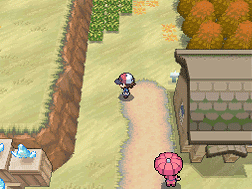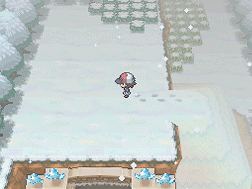Season (game mechanic): Difference between revisions
No edit summary |
|||
| Line 94: | Line 94: | ||
*The background music on most routes changes slightly. | *The background music on most routes changes slightly. | ||
*[[Casteliacone]]s are not sold. | *[[Casteliacone]]s are not sold. | ||
*[[Cynthia]] is not in [[Undella Town]]. | *[[Cynthia]] is not in [[Undella Town]] (unless you haven't fought her yet). | ||
*{{tc|Preschooler}} Winter (if the player is {{ga|Hilbert|male}}) or {{tc|Rich Boy}} Martin (if the player is {{ga|Hilda|female}}) is at the {{DL|Nimbasa City|Rondez-View Ferris Wheel}} in [[Nimbasa City]]. | *{{tc|Preschooler}} Winter (if the player is {{ga|Hilbert|male}}) or {{tc|Rich Boy}} Martin (if the player is {{ga|Hilda|female}}) is at the {{DL|Nimbasa City|Rondez-View Ferris Wheel}} in [[Nimbasa City]]. | ||
* The water in the [[Castelia Sewers]] is drained. | * The water in the [[Castelia Sewers]] is drained. | ||
Revision as of 01:15, 1 August 2012
- If you were looking for the division of dubbed episodes, see season.
| May is spring | |||
|---|---|---|---|
Spring |
Summer | ||
Autumn |
Winter | ||
| 19 days until summer! | |||
Seasons are a mechanic of the Pokémon games. The concept was introduced in Generation V.
Much as Generation II introduced time and days of the week to the Pokémon series, and Generation IV used the Nintendo DS's internal clock to keep track of the date of capture of a particular Pokémon, seasons are a new feature introduced in Generation V. However, seasons will not change in-game automatically; they will change only upon exiting a cave or building. Unlike in the real world, where each season lasts for approximately three sequential months, the seasons in Unova will change each month, going through the full cycle of spring, summer, autumn, and winter three times per year.
Spring
Spring occurs in January, May, and September.
Effects
- Morning begins at 5:00 AM, while Day lasts until 7:59 PM.
- Deerling and Sawsbuck appear in their Spring Form.
- Snow is not present in any locations.
- Certain areas may have rain.
- Some wild Pokémon encounter rates change.
- The background music on most routes changes slightly.
- Casteliacones are sold on TuesdaysWrong template. See Template:Sup/doc./every dayWrong template. See Template:Sup/doc..
- Cynthia is in Undella Town and will battle the player daily; female Elite Four members may visit her.
- Lass Maya (if the player is male) or Dancer Dirk (if the player is female) is at the Rondez-View Ferris Wheel in Nimbasa City.
- N will battle with his spring team at N's Castle.
Summer
Summer occurs in February, June, and October.
Effects
- Morning begins one hour earlier, at 4:00 AM, while Day lasts an hour longer, until 8:59 PM.
- Deerling and Sawsbuck appear in their Summer Form.
- Snow is not present in any locations.
- Some wild Pokémon encounter rates change.
- The background music on most routes changes slightly.
- Casteliacones are sold on TuesdaysWrong template. See Template:Sup/doc./every dayWrong template. See Template:Sup/doc..
- Cynthia is in Undella Town; female Gym Leaders members may visit her.
- Hiker Andy (if the player is male) or Ace Trainer Austin (if the player is female) is at the Rondez-View Ferris Wheel in Nimbasa City.
- There will be additional NPCs in Undella Town, one of whom will trade his Munchlax for a Cinccino.
- N will battle with his summer team at N's Castle.
Autumn
Autumn occurs in March, July, and November.
Effects
- Morning begins at 5:00 AM, while Day lasts until 7:59 PM.
- Deerling and Sawsbuck appear in their Autumn Form.
- Snow is not present in any locations.
- Some wild Pokémon encounter rates change.
- The background music on most routes changes slightly.
- Casteliacones are sold on TuesdaysWrong template. See Template:Sup/doc./every dayWrong template. See Template:Sup/doc..
- Cynthia is not in Undella Town.
- Clerk ♀ Trisha (if the player is male) or Waitress Aurora (if the player is female) is at the Rondez-View Ferris Wheel in Nimbasa City.
- Fallen leaves are present on Route 20.
- Due to leaves piling up, certain areas can be accessed that are normally inaccessible.
- The water in the Castelia Sewers is drained.
- N will battle with his autumn team at N's Castle.
Winter
Winter occurs in April, August, and December.
Effects
- Morning begins one hour later, at 6:00 AM, while Day lasts an hour shorter, until 6:59 PM.
- Deerling and Sawsbuck appear in their Winter Form.
- Snow is present in Twist Mountain, Icirrus City, Route 8, Moor of Icirrus, and Dragonspiral Tower; all puddles in these locations are frozen over, acting as ice tiles. Small patches of snow are also present in other locations, such as Driftveil City.
- Due to snow piling up, certain areas can be accessed that are normally inaccessible, while certain cave entrances in Twist Mountain are covered by it.
- Hail and rain are common in Driftveil City, Cold Storage, Route 5, and Mistralton City. Hail and blizzards are common in Icirrus City and Route 8.
- Some wild Pokémon encounter rates change.
- The background music on most routes changes slightly.
- Casteliacones are not sold.
- Cynthia is not in Undella Town (unless you haven't fought her yet).
- Preschooler Winter (if the player is male) or Rich Boy Martin (if the player is female) is at the Rondez-View Ferris Wheel in Nimbasa City.
- The water in the Castelia Sewers is drained.
- N will battle with his winter team at N's Castle.
Trivia
- As February is included among the months considered as summer, it is the shortest season on average. Where the other seasons each last a total of 92 days in a real-time year, summer lasts a total of 89 days or, in case of a leap year, 90 days.
- Interestingly, this is true for the southern hemisphere summer, as the Earth is near perihelion. Summer lasts only approximately 89 days, while winter lasts closer to 94. The opposite is in effect for the northern hemisphere.
- When summer and winter start in the northern hemisphere of the real world, the same season is in effect in-game. This is not true for spring and autumn, whereas it is spring in-game when autumn starts in real life and vice versa.
- The opposite is true for the southern hemisphere: real-world spring and autumn start in months with their respective in-game seasons, while summer and winter start in in-game winter and summer respectively.
- In some countries, most notably in North America and parts of Europe, seasons start at solstices and equinoxes, rather than starting at the first day of a month as is the case in countries like Australia. In such cases, all four seasons appear in-game in each real life season.
- Black and White, the first games to introduce this feature, were released during autumn in Japan, and the in-game season was spring. The international releases were released in what is generally considered to be spring in the northern hemisphere, and the in-game season was autumn.

|
This game mechanic article is part of Project Games, a Bulbapedia project that aims to write comprehensive articles on the Pokémon games. |

